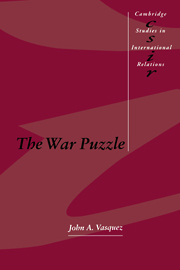Book contents
- Frontmatter
- Contents
- Preface
- PART I PRELIMINARIES
- PART II THE ONSET AND EXPANSION OF WARS OF RIVALRY
- 4 TERRITORIAL CONTIGUITY AS A SOURCE OF CONFLICT LEADING TO WAR
- 5 THE REALIST ROAD TO WAR
- 6 THE DOMESTIC PREREQUISITES OF WARS OF RIVALRY
- 7 EXPLAINING WORLD WAR: ITS SCOPE, SEVERITY, AND DURATION
- 8 PEACE
- 9 CONCLUSION: SOLVING THE PUZZLE OF WAR
- Appendix: A propositional summary
- Notes
- References
- Index
- Titles in series
7 - EXPLAINING WORLD WAR: ITS SCOPE, SEVERITY, AND DURATION
Published online by Cambridge University Press: 07 December 2009
- Frontmatter
- Contents
- Preface
- PART I PRELIMINARIES
- PART II THE ONSET AND EXPANSION OF WARS OF RIVALRY
- 4 TERRITORIAL CONTIGUITY AS A SOURCE OF CONFLICT LEADING TO WAR
- 5 THE REALIST ROAD TO WAR
- 6 THE DOMESTIC PREREQUISITES OF WARS OF RIVALRY
- 7 EXPLAINING WORLD WAR: ITS SCOPE, SEVERITY, AND DURATION
- 8 PEACE
- 9 CONCLUSION: SOLVING THE PUZZLE OF WAR
- Appendix: A propositional summary
- Notes
- References
- Index
- Titles in series
Summary
World wars are the great accidents of European history.
World war has been the scourge of the twentieth century. The world wars of this century have fundamentally altered the modern global system. The idyllic aristocratic way of life that had lingered in Europe since 1815 (Mayer, 1981) came to a crashing end in the summer of 1914. The legacy of the cataclysm produced an even more destructive and total war for the next generation. In that war, the search for the ultimate weapon inaugurated an ominous nuclear era with the prospect of complete annihilation. Such has been the inheritance of the twentieth century, and it accounts in large part for the persuasiveness of realist thought and its obsession with power.
Realists have explained world war as part of a hegemonic struggle for power that is endemic in history. This chapter provides an alternative explanation to show that even where the realist paradigm has focused most of its attention a more plausible and less problematic interpretation of the major events of this century can be derived from a non-realist perspective.
While the alternative explanation treats world war as special, it does not, like most realist accounts, see world war as requiring its own theory of war. The steps-to-war analysis presented in this book assumes that the causes of world wars are the same as the causes of any war of rivalry; that is, they flow out of attempts to use power politics. Yet, world wars are different. More than any other kind of war, their specific characteristics and their profound impact on both global and domestic systems are unanticipated.
- Type
- Chapter
- Information
- The War Puzzle , pp. 225 - 262Publisher: Cambridge University PressPrint publication year: 1993



